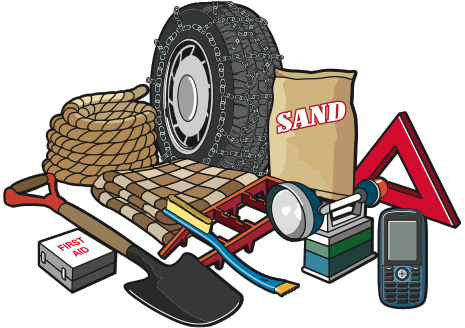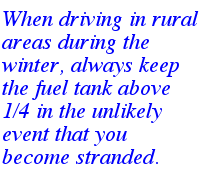Winter Survival Kit
December 3, 2014
If you’re journeying outside of urban areas during the winter months, preparation is imperative for your safe arrival. Ensure that your vehicle is ready: winter tires if needed, windshield wiper fluid topped up, and you’re wearing comfortable clothing. Have you shifted your driving into winter? Increasing space margins, braking earlier and reducing speeds when road conditions deteriorate will help you to arrive safely at your destination. Finally, prep your vehicle with an emergency survival kit in the unlikely event that you end up in the proverbial “rhubarb”.
Stocking your vehicle with some, or all of the following items will improve your chances of survival should you experience the unfortunate event of becoming stranding during the winter months in an isolated location.

1) Fully charged cellular phone – it is imperative that you can text or call for help if your vehicle becomes disabled
2) Candle – provides heat and allows you to melt snow for drinking water – a bigger candle works better because it will stand up better – a shallow, flat dish will work well to prevent the candle from being knocked over.
The problem with flashlights, are that the batteries go dead – and the batteries are often inoperable when you need these the most. Consequently, a candle and lighter is going to work in your time of need.
3) Lighter – waterproof matches simply don’t work if these get wet or damp
4) Pot or metal bowl to melt snow
5) Non-perishable food items (granola bars, trail mix, dried fruit in a seal package
6) Warm blanket – 2 or 3 blankets are better; the plastic emergency blankets sold in low-end camping stores simply don’t work. It is better to just put in bulky blankets from the linen closet – in the event of an emergency, you’ll be glad you did

7) Touque or warm hat, mittens, jacket and other warm clothes – the majority of heat loss is through you head, therefore a touque or warm hat is a key piece of clothing to keep you warm
8) First aid supplies – most pharmacies have basic kits that are relatively inexpensive. Medical supplies are important in the event of injury if your vehicle goes out of control and ends up in the ditch
9) Traction – carpet strips, sand or kitty litter for traction
10) Small shovel – if your vehicle ends up in the ditch, it might be a simple matter of getting a bit of traction, or shoveling a small amount of snow to get back on the road; however, if you don’t have sand or a shovel, this action won’t be possible
11) Ice scraper and brush – it is important that the windshield and all windows are cleared before venturing out
If you are travelling in remote locations, it is recommended that you learn how to change a tire – and if it is a regular tire, ensure that it is inflated, you know where to find the jack, and where the jack should be placed under the vehicle (see owner’s manual).
Special Needs Items, for example: diapers or formula, prescription medicines and copies of prescriptions, hearing aid batteries, spare wheelchair battery, spare eyeglasses, or other physical needs.
As well, if you are driving outside of urban areas do not operate your vehicle with less than a ¼ tank of fuel – if you do become stranded, you will need enough fuel to run the engine every so often to provide heat (10 or 15 minutes every hour is recommended, and – ensure a window is opened slightly to prevent carbon monoxide buildup in the cabin)
Depending on the severity of winter in your region and the remoteness of you commute, you may want to add the following items to you winter survival kit:
- Tow rope or chain
- Booster cables
- Road flares or warning lights (these however, are a requirement for the commercial driver)
- Gas line antifreeze
Winter driving requires some additional skills; however, these techniques and abilities can be learned and employed with a bit of planning and forethought. Take some time to equip your vehicle, and make it through the winter safely.
(Photo by Quinn Dombrowski / CC BY)





